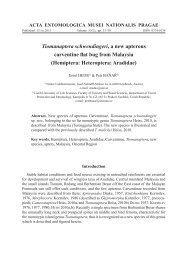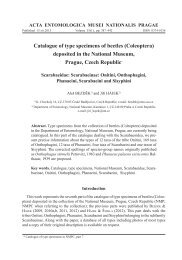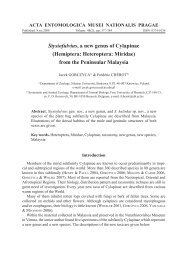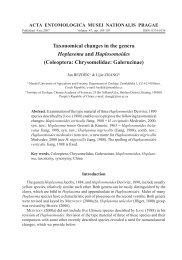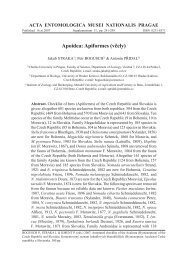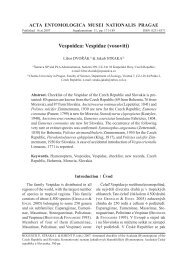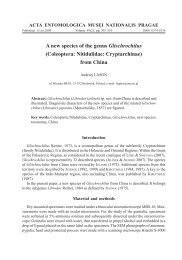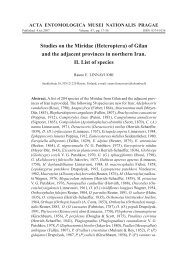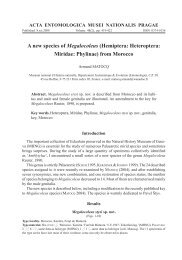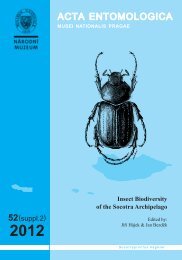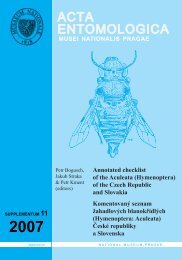Revision of the Palaearctic species of the Coccinella ...
Revision of the Palaearctic species of the Coccinella ...
Revision of the Palaearctic species of the Coccinella ...
Create successful ePaper yourself
Turn your PDF publications into a flip-book with our unique Google optimized e-Paper software.
Acta Entomologica Musei Nationalis Pragae, 45, 2005 155<br />
inner hook-shaped branch moderately curved dorsally, roundly truncate at apex, dorsal rib<br />
strongly developed, semicircular. Siphonal tube at base subrectangular, <strong>the</strong>n straight, preapical<br />
portion with supporting sclerites moderately dilated both dorsally and ventrally but narrowed<br />
laterally, bearing two swellings: proximal one small and on each side longitudinally<br />
oval, remaining partly free, apical one strikingly enlarged ventrally. Terminal ampulla <strong>of</strong> sipho<br />
moderate, triangular.<br />
Female genitalia. Genital plate (hemiventrite 9) robust, blade-shaped, more than twice as<br />
long as wide, apex quite asymmetrically truncate, gradually arched outwards. Stylus well<br />
developed, cylindrical, bearing usually five setae. Sperma<strong>the</strong>ca C-shaped, nodulus and ramus<br />
moderately long, somewhat narrower than cornu, nodulus about 1.5 times longer than ramus,<br />
cornu strongly curved, without dilated portion, slightly straightened distally. Infundibulum<br />
about as long as sperma<strong>the</strong>ca thick, with cylindrical body equally enlarged at both ends, distal<br />
end campaniform, nearly 0.33 times as long as infundibulum.<br />
Length. Males (n = 17) 5.00-6.56 mm; females (n = 14) 5.08-6.72 mm. MULSANT (1850a)<br />
gives 5.6-7.8 mm for all populations; WEISE (1885, 1892) reports 5.5-8 mm, DOBZHANSKIY<br />
(1926) 5.9-7.2 mm, BROWN (1962) 6.0-7.2 mm and IABLOKOFF-KHNZORIAN (1982) 4-8 mm.<br />
Variability. <strong>Coccinella</strong> transversoguttata is widely distributed in <strong>the</strong> Holarctic region and is<br />
represented by four sub<strong>species</strong> in <strong>the</strong> New World. <strong>Coccinella</strong> t. richardsoni Brown, 1962,<br />
common and widely distributed in <strong>the</strong> main part <strong>of</strong> America north <strong>of</strong> Mexico, and C. t.<br />
ephippiata Zetterstedt, 1838, restricted to <strong>the</strong> coastal parts <strong>of</strong> Greenland, are both moderately<br />
convex. Two montane populations described as distinct <strong>species</strong> from Mexico are only slightly<br />
convex and are now considered as sub<strong>species</strong>: C. t. nugatoria Mulsant, 1850 and C. t. sonorica<br />
Casey, 1908. They perhaps represent isolated, sou<strong>the</strong>rnmost Nearctic populations <strong>of</strong> C.<br />
transversoguttata. Specimens <strong>of</strong> C. t. ephippiata with full elytral pattern are inseparable from<br />
fully spoted <strong>Palaearctic</strong> specimens (BROWN 1962). On <strong>the</strong> o<strong>the</strong>r hand, C. t. richardsoni is very<br />
variable and <strong>the</strong> colour pattern becomes gradually reduced (as for <strong>the</strong> presence <strong>of</strong> an entire<br />
subbasal band and <strong>the</strong> lateral spot) in <strong>the</strong> east-west direction. BROWN (1962) also suggested<br />
that <strong>the</strong> relative width <strong>of</strong> apical hastate portion <strong>of</strong> <strong>the</strong> median lobe <strong>of</strong> <strong>the</strong> aedeagus (measured<br />
as <strong>the</strong> ratio <strong>of</strong> <strong>the</strong> width <strong>of</strong> <strong>the</strong> anterior tongue-shaped process <strong>of</strong> <strong>the</strong> hastate portion to <strong>the</strong><br />
width <strong>of</strong> <strong>the</strong> basal portion <strong>of</strong> median lobe) is important for delimiting <strong>the</strong> sub<strong>species</strong> <strong>of</strong> C.<br />
transversoguttata. It follows from my measurements here (n = number <strong>of</strong> specimens measured)<br />
that this ratio overlaps between sub<strong>species</strong> and cannot be used as <strong>the</strong> only separating<br />
character: 0.28-0.31 (n = 6) for C. t. transversoguttata, 0.27-0.29 (n = 4) for C. t. richardsoni,<br />
0.24 for C. t. ephippiata (BROWN 1962, Fig. 4) and 0.21-0.27 (n = 3) for C. t. nugatoria. It<br />
seems that <strong>the</strong> <strong>Palaearctic</strong> populations are subspecifically more clearly distinct from Nearctic<br />
ones when <strong>the</strong> elytral pattern is considered.<br />
The nominate sub<strong>species</strong>, treated here, occurs only in <strong>the</strong> Old World and has <strong>the</strong> broadest<br />
hastate portion <strong>of</strong> median lobe <strong>of</strong> aedeagus (see above). The black elytral spots are complete<br />
and usually more strongly developed than that in <strong>the</strong> Nearctic populations, and may be isolated<br />
(Fig. 89) or gradually confluent in <strong>the</strong> pattern <strong>of</strong> ½, 1, 2, 3 and 4+5 (Fig. 90), ½+1, 2, 3, 4<br />
and 5 (Fig. 91), and (commonly) ½+1, 2, 3 and 4+5 (Fig. 92), forming a subbasal band. The<br />
latter pattern is nearly invariably present in nor<strong>the</strong>rn populations inhabiting West and East<br />
Sibiria, Far East <strong>of</strong> Russia and Mongolia. Middle Asian and Chinese populations are more



